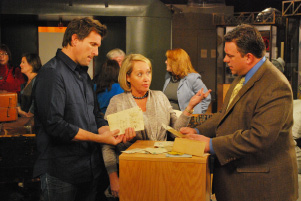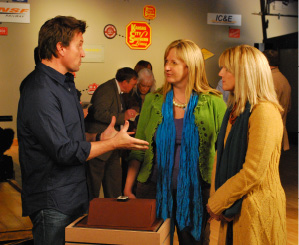
By Leslie Collins
Northeast News
January 18, 2012
“I need another reaction,” the director shouted.
Video cameras, crew members and extras filled the downstairs of Union Station.
This was now the set of National Geographic Channel’s (NGC) new television series “America’s Lost Treasures.”
A cameraman zoomed in on the Shawnee, Kan., history and archeology teacher Keil Hileman, who just learned the worth of his World War II era ceramic hand grenades.
“I think the most I’ve paid (for one) is $80,” Hileman said.
Their worth? $200 to $400 each.
Dozens of area residents showed off their “lost treasure” in Kansas City Jan. 11, the sixth stop for “America’s Lost Treasures.” NGC is filming in 10 cities across the U.S. in search of objects with “historical importance and unexpected value.”
Each show will feature five to six objects and one winner will be chosen in each city. Winners will receive $10,000 each, along with the chance to display their items in a year-long exhibit through “America’s Lost Treasures.” NGC filmed the Kansas City finale, which revealed the winner, at the Kansas City Museum in Historic Northeast.
“We’re really honored because National Geographic is about as serious as you can get with the study of history and culture,” said Christopher Leitch, Kansas City Museum historic house director. “It’s an opportunity for the museum to be visible doing what a museum does, being a venue for community history.”
Asked what sets this show apart from others, Maggie Nye, public relations for “America’s Lost Treasures,” said, “We really delve into the history of the item rather than just give a monetary value.”
Local museum staff, as well as experts and appraisers, research the item’s history and give viewers a behind-the-scenes look at the local museum’s research center.
“It’s very surprising what people have in their homes,” Nye said. “Sometimes we don’t always realize we have absolute treasures sitting on the dresser.”
Artifacts they’ve found in cities so far have ranged from dinosaur bones to a book bound in human skin to a light bulb prototype. In Kansas City, they’ve discovered state documents from the 1850s, a daguerreotype and a pistol allegedly linked to Jesse James, said “America’s Lost Treasures” Co-host Curt Doussett.
“It’s phenomenal getting to see items that have been in people’s basements and garages that have real historic value,” Doussett told Northeast News. “I’m a history fanatic and this is all about America’s history. I was very fortunate to be picked to do this – this is right up my alley. To get to do something professionally and personally that I’m passionate about is like lighting striking twice.”
For Hileman, being on set provided more than a glimpse into Hollywood. It revealed another facet of history.
“I learned more in five minutes (from the historian) and I’ve been looking for 10 years,” he said of the Japanese hand grenades.
Hileman skipped school to attend and brought along two of his students, Austin Atchison and Allison Kelsey. Together, they talked to Doussett about the hand grenades and watched as others showed off their items.
“They said so far this show has had more response and artifacts than any of the others. How cool is that?” Hileman said.
One of those artifacts included a thunderbird Indian artifact brought in by sisters Janie Jones and Ginger Broyles. For years they’ve speculated about the value of their dad’s thunderbird, which he found in a creek in Manhattan, Kan. Not even the “Antiques Roadshow” could tell them the worth. Forty years ago, an Indian offered their dad $20,000 for the artifact, Jones said. Last January, their dad died, still not knowing the value of his precious thunderbird.
“I want to honor him by finding out (the value),” Broyles said. “I’m still on a quest to find out what he couldn’t himself.”
Another artifact came from Northeast resident and former Pendleton Heights Neighborhood Association President Kent Dicus. Dicus submitted a daguerreotype of his great-great-grandfather, Thomas Jefferson Dobyns.
“Guess who was president when he was born in 1802?” Dicus laughed.
Dobyns owned a chain of photography studios in the 1850s called “Dobyns and Harrington,” which were located in New York City, New Orleans, St. Louis and other cities along the Mississippi River.
“This was really the first way to capture images of people, since photography hadn’t been around since the late 1830s or so,” Dicus said of daguerreotype. “What I think they (NGC) found interesting about him is that not only is it (a daguerreotype) of him, but he was an actual daguerreian photographer. That’s really what he was known for… A couple of his images have gone on sale on Ebay for a couple thousand dollars a piece.”
Now part of the fifth generation to own the daguerreotype, Dicus said it’s an image that’s “irreplaceable.”
As NGO taped the finale at the Kansas City Museum Saturday, Jan. 14, Northeast News grabbed Supervising Producer Adam Flacks for a quick interview.
Asked why he wanted to be a part of the show, Flacks said he has a “fascination with history.”
“My favorite things on the show are times when people really don’t know what they have or they think they have something interesting but don’t know for sure,” Flacks said. “We’re able to take their objects to experts and go back to the owners and say, ‘You have a piece of history.'”
Sometimes the news reveals the item isn’t authentic, but all isn’t lost, Flacks said. There’s still that personal history tied to the item and the owner finally has an answer, he said.
Asked to name a favorite artifact, he said, “It’s tough to pick one. It comes back to those times in cities where we’re able to give people good news. It’s always fascinating and blows my mind when someone has a real piece of history in their home and it’s nice to have it come out and be shared with the world.”
















